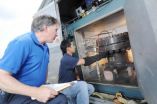(Press-News.org) DURHAM, N.H. – Soil-dwelling bacteria of the genus Frankia have the potential to produce a multitude of natural products, including antibiotics, herbicides, pigments, anticancer agents, and other useful products, according to an article in the June 2011 issue of the journal "Applied and Environmental Microbiology." University of New Hampshire professor of microbiology and genetics Louis Tisa, a Frankia expert, contributed the genomic analysis to this study.
"We were able to use cutting-edge techniques to identify unexpected compounds in this organism, Frankia," Tisa says. The researchers, led by Bradley Moore of the Scripps Oceanographic Institute, found genetic structures in Frankia that resemble those of various valuable natural product categories that produce the majority of the natural antibiotics used as drugs.
Frankia are nitrogen-fixing bacteria that live in symbiosis with actinorhizal plants (whose ranks include beech and cherry trees); they have not previously been exploited partly because these bacteria are difficult to grow in the lab. But new genetic methods make it easier to transplant genes for promising natural products from Frankia into more user-friendly host bacteria for production.
"We found something unique that nobody thought to look for in these bacteria," says Tisa, who worked with his former graduate student and current lab technician Nicholas Beauchemin, on the project.
Tisa's lab provided insight on the biology that contributed to the genome mining, a recent technique that involves searching for genetic sequences, that was critical to the results and "complementary to the far more laborious traditional natural product drug discovery that has gone unchanged for decades," Moore says.
###
The project grew out of a graduate class that Moore and co-author Daniel Udwary (then his post-doc, now at the University of Rhode Island) taught on "Microbial Genome Mining." The students—who are the majority of coauthors on the paper—annotated their genes and based on biosynthetic principles, and predicted pathways leading to putative natural products. They then worked with the laboratories of Pieter Dorrestein at the University of California, San Diego, and Tisa to conduct preliminary proteomic and metabolomic analyses to probe whether the predicted pathways were operative, and whether small molecule chemistry was evident.
The paper is called "Significant Natural Product Biosynthetic Potential of Actinorhizal Symbionts of the Genus Frankia, as Revealed by Comparative Genomic and Proteomic Analyses."
The University of New Hampshire, founded in 1866, is a world-class public research university with the feel of a New England liberal arts college. A land, sea, and space-grant university, UNH is the state's flagship public institution, enrolling 12,200 undergraduate and 2,300 graduate students.
UNH researchers help find natural products potential of frankia
2011-08-04
ELSE PRESS RELEASES FROM THIS DATE:
Are pet owners healthier and happier? Maybe not…
2011-08-04
For many people, Fido and Fluffy are more than just pets, they're true and equal members of the family. And it's not hard to see why. Our pets greet us at the door after a long day of work, settle in our laps while we're watching TV, or 'sing' along when we hum a tune. They provide companionship and even a sense of comfort. We like to believe that our pets are good for us, that they enrich our lives and make us happier, and messages in media and advertising reinforce these beliefs. But is there really a universal 'pet effect' on human mental and physical health? According ...
African rodent uses 'poison arrow' toxin to deter predators
2011-08-04
Woe to the clueless predator trying to make a meal of the African crested rat, a rodent that applies poisonous plant toxin to sponge-like hairs on its flanks, a discovery recently made by Jonathan Kingdon and colleagues from the National Museums of Kenya, the Wildlife Conservation Society, and University of Oxford.
In the only known instance of a mammal acquiring a lethal toxin from a plant for defense, the researchers have discovered where the African crested rat (or maned rat) gets its poison: the Acokanthera tree, the same source used by East African hunters for ...
What's in a kids meal? Not happy news
2011-08-04
High-calorie, high-sodium choices were on the menu when parents purchased lunch for their children at a San Diego fast-food restaurant. Why? Because both children and adults liked the food and the convenience.
However, the study of data compiled by researchers in the Department of Pediatrics at the University of California, San Diego, appearing this week in the new journal, Childhood Obesity, showed that convenience resulted in lunchtime meals that accounted for between 36 and 51 percent of a child's daily caloric needs. In addition, 35 to 39 percent of calories came ...
First large study to find HIV epidemic among gays in the Middle East
2011-08-04
NEW YORK (Aug. 2, 2011) -- HIV epidemics are emerging in several countries in the Middle East and North Africa among men who have sex with men, a term that encompasses gay, non-gay identified homosexual men, and transgendered and bisexual men.
Though HIV infection levels were historically very low in the Middle East and North Africa, substantial levels of HIV transmission have been found, beginning in 2003, among men who have sex with men, a hidden and stigmatized population in this part of the world. These findings are published today in PLoS Medicine and represent the ...
Georgia Tech proposes Internet consumer nutrition label
2011-08-04
When it comes to broadband speeds, U.S. Internet service providers (ISPs) largely deliver on their promises, says a report issued today by the Federal Communications Commission, but "throughput" is only one of several metrics listed in the report that affect network performance. ISPs should provide a broadband "nutrition label"—easy-to-understand information about service-limiting factors—and users need better ways of measuring the performance their ISPs are delivering, concludes a study from the Georgia Tech College of Computing.
Out of some 2 billion Internet users ...
BGU researchers develop webcam tool to improve office worker posture
2011-08-04
BEER-SHEVA, ISRAEL, August 2, 2011– A multidisciplinary team at Ben-Gurion University of the Negev has developed a new training method using a desktop webcam to improve ergonomic posture and reduce the risk of musculoskeletal disorders (MSD) among office workers using computers.
According to an article in Applied Ergonomics in the forthcoming issue, a group of 60 workers received both office training and an automatic frequent-feedback system that displayed a webcam photo of a worker's current sitting posture alongside the correct posture photo taken during office training. ...
Plant biologists dissect genetic mechanism enabling plants to overcome environmental challenge
2011-08-04
Cold Spring Harbor, NY -- When an animal gets too hot or too cold, or feels pangs of hunger or thirst, it tends to relocate – to where it's cooler or hotter, or to the nearest place where food or water can be found. But what about vegetative life? What can a plant do under similar circumstances?
Plants can't change the climate and they can't uproot themselves to move to a more favorable spot. Yet they do respond successfully to changes in environmental conditions in diverse ways, many of which involve modifications of the way they grow and develop.
Plant biologists ...
August 2011 GSA Today science: Understanding Earth's eroding surface with 10Be
2011-08-04
Boulder, Colorado, USA - The August GSA TODAY science article is now online at http://www.geosociety.org/gsatoday/archive/21/8/.
The modification of Earth's surface by erosion is one of the most important geological processes in terms of its impact on society, as well as its influence on the geological record, but geologists have been lacking a well-determined compilation of pre-human rates of erosion. In a groundbreaking compilation of 1528 calculations of surface erosion rates from 80 study areas from all over the world, authors Eric Portenga and Paul Bierman of the ...
Stray-bullet shootings most often harm women and individuals at low-risk for violence
2011-08-04
(SACRAMENTO, Calif.) — In the first nationwide study of stray-bullet shootings, Garen Wintemute, professor of emergency medicine and director of the Violence Prevention Research Program at UC Davis School of Medicine and Medical Center, quantifies mortality and injury among victims of these unexpected events. His research is published as a letter in the August 3 issue of the Journal of the American Medical Association.
"Stray-bullet shootings create fear and insecurity in many communities," said Wintemute. "People stay indoors, don't let their children play outside, and ...
Atmospheric simulations will help NASA interpret data from the Juno Mission to Jupiter
2011-08-04
In August of 2016, when NASA's Juno Mission begins sending back information about the atmosphere of the planet Jupiter, research done by Georgia Institute of Technology engineers using a 2,400-pound pressure vessel will help scientists understand what the data means. The Juno probe is scheduled to be launched August 5 from Cape Canaveral Air Force Station in Florida.
Because Jupiter has been largely unchanged since its formation at the birth of our solar system, scientists hope Juno will resolve unanswered questions not only about the massive planet, but also about how ...

